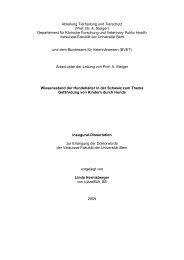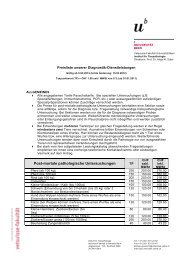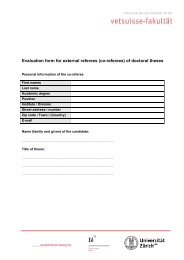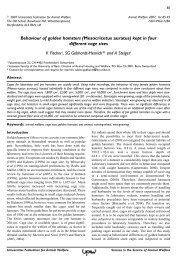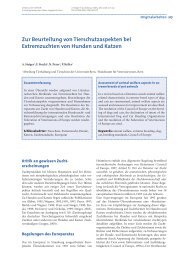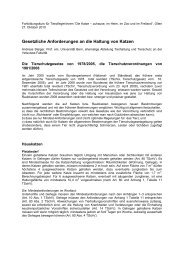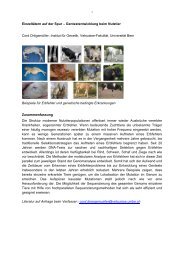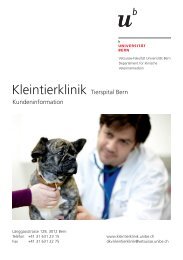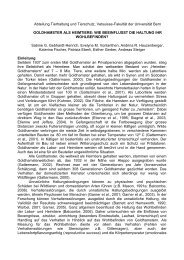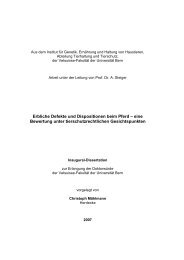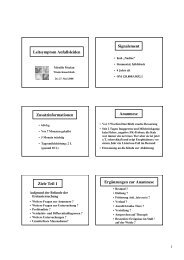Behaviour of golden hamsters (Mesocricetus auratus) - Vetsuisse ...
Behaviour of golden hamsters (Mesocricetus auratus) - Vetsuisse ...
Behaviour of golden hamsters (Mesocricetus auratus) - Vetsuisse ...
Create successful ePaper yourself
Turn your PDF publications into a flip-book with our unique Google optimized e-Paper software.
MethodsAnimals and housing conditionsThe sixty female <strong>golden</strong> <strong>hamsters</strong> used for this project were progeny <strong>of</strong> the strain Crl:LVG (SYR) from Charles River, Germany. During one year the sixty <strong>hamsters</strong> werebred in three series <strong>of</strong> 20 <strong>hamsters</strong> each. A photoperiod <strong>of</strong> 12h light, 12h dark, dawnat 1300h was maintained. The light decreased from 280 Lux within half an hour tomaximal 5 Lux. Room temperature was 21±2°C, relative humidity was not regulated,but was between 25% and 59%. Hamsters were bred in cages with a wire top andplastic bottom (length x width x height: 95 cm x 57 cm x 45 cm) without a runningwheel. At the age <strong>of</strong> 24 to 30 days <strong>hamsters</strong> were placed singly into four differentsized cages (App. I to III). Size 1 was: 32 cm x 57 cm x 45 cm (length x width xheight), (approx. 1,800 cm 2 ); size 2: 44 cm x 57 cm x 45 cm, (approx. 2,500 cm 2 ),size 3: 95 cm x 57 cm x 45 cm, (approx. 5,000cm 2 ), and size 4: 105 cm x 95 cm x 45cm (approx. 10,000 cm 2 ). All cages were furnished with a wooden nest box (20 cm x14 cm x 14 cm), litter (depth: 15 cm), hay, paper towel, cardboard tubes, twigs, asand bath (diameter: 16 cm) and a running wheel (diameter: 30 cm, width: 10 cm).Commercial pet hamster food (Witte Molen®, NL-Meeuwen) and water were <strong>of</strong>feredad lib. This diet was amended by dry cat food and vitamin and mineral supplements(Marienfelde Vitakalk). In addition, fresh fruits and vegetables were added every day.Litter was never changed completely. Only the dirty parts <strong>of</strong> the litter were changedwhen necessary. Due to space limitations, the project was made in 3 series. Fivecages <strong>of</strong> each size were used simultaneously. In each <strong>of</strong> the three series, 20<strong>hamsters</strong> were distributed singly in the 20 cages. If possible, <strong>hamsters</strong> <strong>of</strong> one litterwere placed randomly, but according to their body mass, in cages <strong>of</strong> 4 different sizes.The experiment was approved by the Cantonal Office <strong>of</strong> Agriculture and Nature.8



